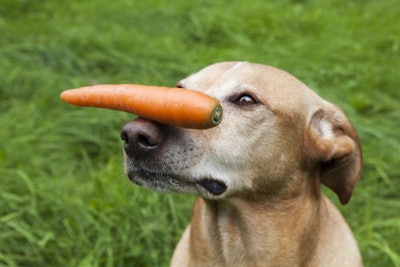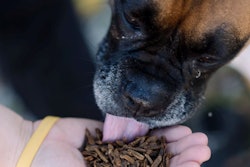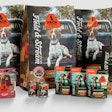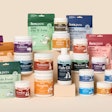
Market analysts at Nielsen tabulated that pet owners in the United States spent approximately US$33 million on pet foods with human-grade products, such as fruits and vegetables, in 2018. Nielsen reported the top five fruits and vegetables found in pet foods as measured by value sales.
- Carrots – US$3.42 billion
- Beet – US$1.85 billion
- Ancient grains – US$1.80 billion
- Sweet potato – US$1.07 billion
- Blueberry – US$761 million
Fruits and vegetables make their way into pet food in numerous ways, just as they do in human foods. While many fruits and vegetables are included in traditional kibble formulations made on extruders, other technologies have become available to the pet food ingredient industry.
Freeze-drying and air-drying have grown in popularity, since they allow preservation of perishable ingredients without high temperatures processing. Also, dried fruits and vegetables still look like what they are.
Increasingly pet owners like to see chunks of fruit or shreds of carrot in their pet food. Dog and cat owners’ desire to see recognizable vegetable ingredients in their pets’ foods has become an influential trend in wet pet food, said Jeroen Boensma, area sales manager at SELO Food Processing, during his presentation at Foro Mascotas 2018 in Guadalajara, Jalisco, Mexico. This trend influences how pet food manufacturers process their products.
Dehydrated ingredients increased in pet food
Nielsen’s analysts also noted that dollar sales of air-dried or dehydrated full meal pet foods more than doubled during the past three years. In 2015, U.S. sales of air-dried or dehydrated pet diets stood at US$23 million. That figure grew to US$53 million in 2018. That means dehydrated pet foods now comprise 1% of total dry foods.
Between freeze-dried and air-dried pet foods, there is a large price jump. Freeze-dried pet foods cost pet owners approximately US$33 per pound, whereas air-dried or dehydrated pet food costs approximately US$11 per pound.
“For brands looking to ride this trend, investing in education is critical,” wrote Nielsen analysts. “That’s because consumers will need to understand the differentiating benefits of freeze-drying and air-drying/dehydrating and why it’s worth a higher price tag.”

















